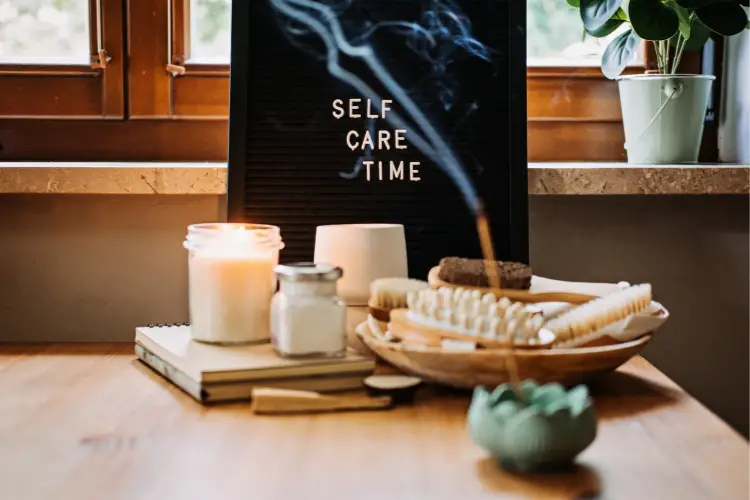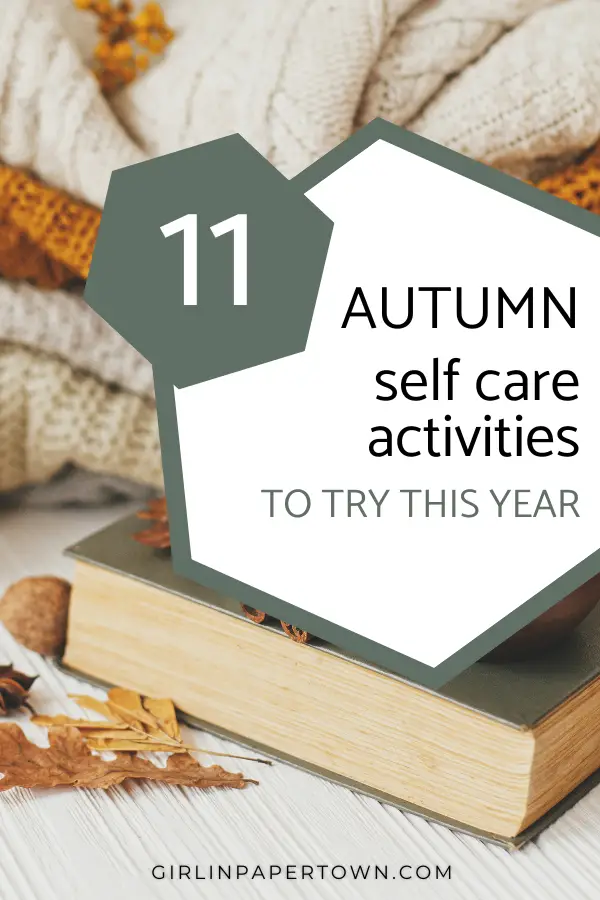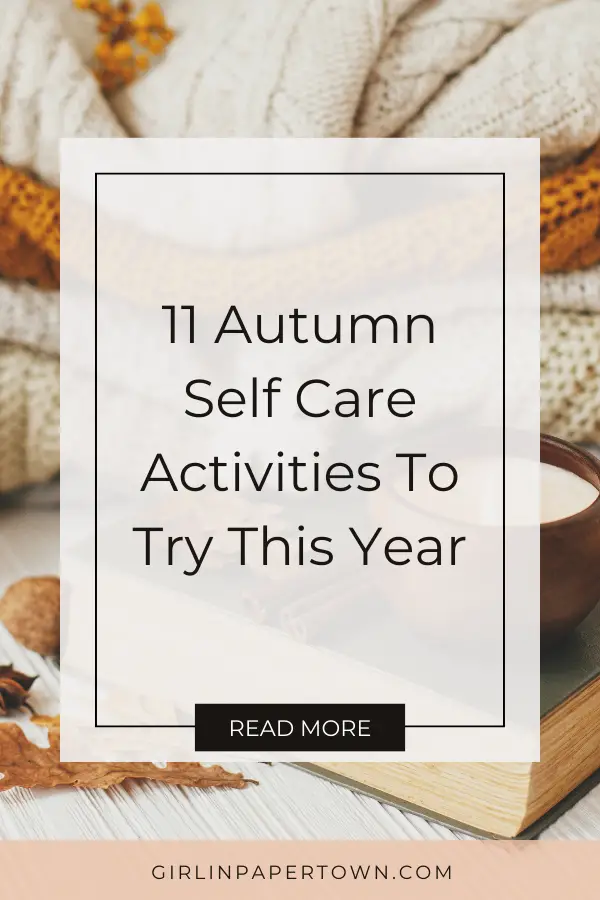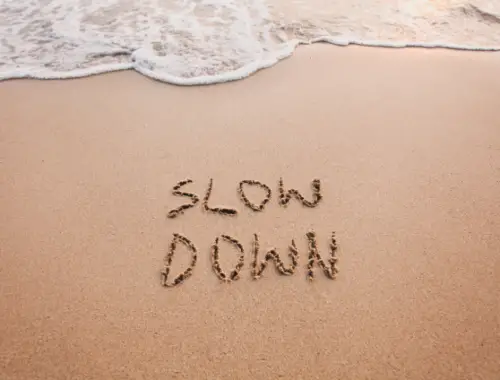11 Autumn Self-Care Ideas for Overcoming Anxiety and Depression
Some of the links in this post are affiliate links which means I earn a small commission if you purchase or book through my link, at no extra cost to you.

Autumn is without a doubt my favourite time of the year. Leaves change their colour to beautiful hues of red and orange, the air turns crisp, and evenings become longer, making this time so, so cosy. But it all comes with its own set of challenges.
With shorter days and less sunlight, your mood might worsen, especially if you struggle with anxiety and depression throughout the year.
I know how difficult it can be and that’s why I prepared this list of autumn self-care ideas for overcoming anxiety and depression. Taking care of yourself is so important, yet often overlooked and deemed silly and a waste of time. So, let’s dive in!
Navigate to where you want to go:
What are 5 easy self-care ideas for fall?
There are days when we don’t want to read long articles, aren’t there? If that’s exactly how you feel today, here’s the short list of easy autumn self-care ideas:
1. Take a walk to enjoy the fall foliage
Taking a walk is great for your mental health. It’s a perfect activity to clear your mind, spend quality time with your family or friends, and unwind. And it’s free!
Also, don’t forget to let your inner child free and skip through the heaps of the leaves.
2. Sip on some warm herbal tea
Or cocoa. Without your phone. Disconnect for a minute and be present in the moment. Notice how you feel, what you see in front of you, and what the world looks like outside. Just take a break and enjoy the moment.
PIN FOR LATER!


3. Start a gratitude journal
I know, I know. Journaling seems… childish? At least it was how I portrayed it at the beginning. Once I started journaling every day as a part of a 3-month challenge, I noticed how my mental wellbeing improved.
Gratitude journaling has been proven to positively influence your mental health. So, what stops you from doing it? Just take an empty notebook and get started!
4. Try a pumpkin-spiced self-care product
Pumpkin spice latte, anyone? I don’t enjoy it, to be honest with you, but I don’t know anyone else who would share my opinion. If you’re like me, though, and don’t exactly love pumpkin-spiced things, swipe it for cinnamon or chocolate! No excuses 😉
5. Cosy up with a good book
Long evenings are perfect for cosying up with a good book and nobody will convince me otherwise. Check your TBR pile and pick something that you’ve wanted to read for a while and just do it.
Why do you need self-care?
Self-care is not a luxury; it’s a necessity, especially for those dealing with mental health issues like anxiety and depression. It took me ages to truly understand it.
Self-care is all about taking time to recharge, to fill your cup before you pour into others. Once you do that, you’ll have lots of strength and energy to tend to your chores and responsibilities.
The impact of autumn on mental health
Autumn can be a difficult time for many, not just for those having depression and anxiety. Shorter days and the lack of sunlight can contribute to Seasonal Affective Disorder (SAD), also known as “winter depression”. That’s why focusing on self-care during this season is even more crucial.
If you have anxiety and depression all year long, you might know that they get worse once you forget about regular self-care.
Every day you skip your self-care activities, it’s just getting more and more difficult to get back to them.
I wholeheartedly believe that you need lots of self-care in your daily life to fight depression and anxiety successfully.
11 autumn self-care ideas
1. Warm baths with autumnal scents
There’s nothing better than taking a hot bath after a long, busy day. Add autumnal scents or bath salts to elevate your experience. Cinnamon, pumpkin, and apple are great to start with!
There are also lots of seasonal bath bombs to buy in almost every larger store, so make sure to grab one of them next time you go shopping.
2. Tarot reflection
Hear me out.
Tarot can help with personal healing and self-mastery during the transformative season of autumn.
Yup, you heard it right. I know that it’s usually considered a tool for fortune-telling and mystical predictions, but, at their core, tarot cards are a reflection of the human experience. They can serve as a mirror to our subconscious minds when used with the right intention.
It’s not for everyone, that’s for sure. I come from a very religious family who frown upon anything divination and magic related, so naturally I was very sceptical about it in the beginning.
But if you’re open-minded and interested in trying new tools in your healing journey, tarot cards might be something worth looking into.
3. Try crafting
Crafting seems to get more popular each autumn, doesn’t it?
Knitting, crocheting, cross stitching… there are lots of different activities to pick from. Making autumn wreaths out of things found outside during a walk can be a great start. There’s also Halloween just around the corner!
Engaging in crafts also has meditative qualities. It helps you forget about everything that makes you anxious and allows you to focus solely on expressing yourself by being creative.
4. Digital detox
Take time away from screens to enjoy the real world.
In an era of constant connectivity, unplugging can be really refreshing. Limiting usage of electronic devices can help you sleep better, feel less anxious, and connect more with others.
I love detoxes like that and even tried weekly social media detox in the past. It was difficult, but definitely worth it.
Autumn seems like a perfect time to limit usage of your devices and swap an hour or two of screen time for reading, spending time outdoors, or crafting.
5. Cosy up with a book
I wouldn’t be myself if I didn’t mention reading. Books have a unique way of transporting us to different worlds.
A cosy spot with soft lighting, blankets, and perhaps a window view of the outdoors provides a perfect environment for reading. It’s a great (and very inexpensive) way of escaping the reality for a moment or two.
6. Journaling
Journaling is more than just writing – it’s a dialog with yourself. The changing season and end of the year slowly creeping in, often prompts introspection.
Documenting your thoughts, fears, and dreams gives voice to your internal feelings. It can be really helpful in battling anxiety and depression as you’re more likely to discover patterns that hold you back or weight you down.
I enjoy journaling but I haven’t been doing it regularly lately. One thing that helps me journal more often, are tarot cards.
I like to pull one card in the morning asking what do I need to know today. Then, I try to read the message cards give me and see how it applies to my life. Tarot journaling is like guided journaling, but prompts change every day and you never really know what to expect, which makes it a lot more interesting.
I have to admit, though, there hasn’t been a day where tarot wouldn’t “work” for me.
7. Gardening
Gardening is such an amazing, grounding activity. Digging in the soil, planting bulbs, clearing fallen leaves, removing weeds… There are lots of things to be done in the autumn!
Even if you don’t have lots of space in your garden, you can plant kitchen herbs on the windowsill or dedicate one or two pots for veggies.
Gardening is amazing for mental health and gives you also a sense of accomplishment. Being able to harvest your own fruits and vegetables feels amazing!
8. Yoga
Yoga harmonises the mind and body. Calming poses and deep breathwork can be beneficial, especially during autumn, when days are getting shorter and colder. Yoga helps you release emotions, clear your mind, and connect with your inner self.
9. Mindfulness and breathing exercises
Each day, take a few minutes to focus on your breath. Disconnect from the outer world, leave your phone alone, and just be in the moment.
Practising regular mindful breathing can benefit your well-being by reducing anxiety, increasing presence, and regulating your nervous system.
It costs nothing and takes very little time. Just try some breathing exercises like box breathing before falling asleep and see if you like it.
10. Nature walks
Once autumn arrives, we tend to cosy up at home and rarely go outside. Even though I love this time of the year, I stay indoors because I don’t have enough motivation left to go outside, when I know I won’t be able to come back to a warm home.
But, walks in nature have many benefits.
They can serve as a meditation, drawing you into the present moment. Immersing yourself in natural beauty also reduces stress and boosts your mood.
So, even if it’s difficult to leave the reprieve of your warm blankets, try to go for a walk every day.
11. Warm beverages
As the temperature drops, there’s comfort in warmth. A cup of herbal tea or hot cocoa isn’t just a drink; it’s an experience.
Holding a warm mug can be soothing, and the act of sipping slowly can be a momentary reprieve from the day’s stresses.
So, what’s holding you back? Make yourself a warm drink now 😉
PIN FOR LATER!


How can I enjoy autumn?
To truly enjoy autumn, engage in activities that make you feel alive and connected. Whether it’s taking a walk in the crisp air, enjoying the seasonal foods, or meditating to the sound of a campfire, find what makes this season special for you. You can also try to weave seasonal elements into everything you do.
Engage in activities that energise your mind and body and make a list of autumn self-care ideas you love or want to try. And, most importantly, focus on positives. Try to avoid negative thoughts that feed your depression and anxiety.
Types of self-care
- Physical self-care involves activities that influence your physical health and well-being. It can be anything, from going for a walk, getting a full night of sleep, taking a long bath, to exercising and drinking lots of water. This type of self-care is the most popular, as people often think of exercising or eating healthy when they think of self-care.
- Emotional self-care is all about stress management and emotional literacy. Think of all the activities that help you connect and process your emotions healthily, like journaling, being creative, or going to a therapy. Taking care of your emotions becomes even more important in autumn, a season that can bring about mood changes and increased stress.
- Intellectual self-care revolves all around activities that stimulate your mind. You can practise this type of self-care by doing things like reading a book, trying a new hobby, writing, or listening to a podcast.
- Social self-care is one that we rarely think of. It’s all about nurturing your relationships with other people. All activities like spending time with your loved ones, going on a date, calling friends/family, or hosting a game night fall into this category.
- Spiritual self-care consists of activities that help you connect with your inner self and nurture it. Think meditation and being mindful. Don’t be put off by the name, as there are lots of non-religious thing that are an act of spiritual self-care. Practising yoga and spending time in nature are another two examples that fit into this category.
- Practical self-care is all about fulfilling core aspects of your life in order to reduce stress. You can create a budget, meal prep, or deep clean your home to make your life easier and limit the amount of things that worsen your anxiety. Everyone has a mental list of all the things they have been postponing for weeks. And as the onset of colder weather and shorter days makes daily tasks feel more difficult to do, your stress levels might go up significantly.
What kind of self-care do you need?
Self-care isn’t one-size-fits-all. There are lots of different types of self-care, with six mentioned above being the most common ones.
Before you jump into action, identify what do you specifically need. Is it emotional support, physical activity, or perhaps spiritual grounding?
Only by taking a pause and doing a body scan you will know what you lack the most and what self-care activities will meet those needs.
Autumn self-care challenge
Why not make self-care a regular habit this season? Challenge yourself to engage in at least one self-care activity per day throughout this autumn.
Keep track of your progress and reflect on how each activity affects your mental well-being.
Commit to at least one week of daily autumn self-care activities and see how it makes you feel. I bet it will help you fight and counteract a low mood.
Final words for autumn self-care ideas
Autumn, with its introspective vibes, can be a challenging time for mental health, but it’s also a season full of opportunities for self-care. Just look through the window and notice how plants are changing colours and the air gets cooler and crispier.
As trees are shedding their leaves, they hint a message for us – to release and transform. To let go of things that weight you down and add to anxiety and depression.
Focus on yourself and prepare for new beginnings. Embrace the season and indulge in various autumn self-care ideas before we jump into the festive whirlwind of December.
So there you have it, your autumn self-care toolkit. Now, which self-care activities are you excited to try first? Let me know in the comments below!
Rooting for you,
M.



